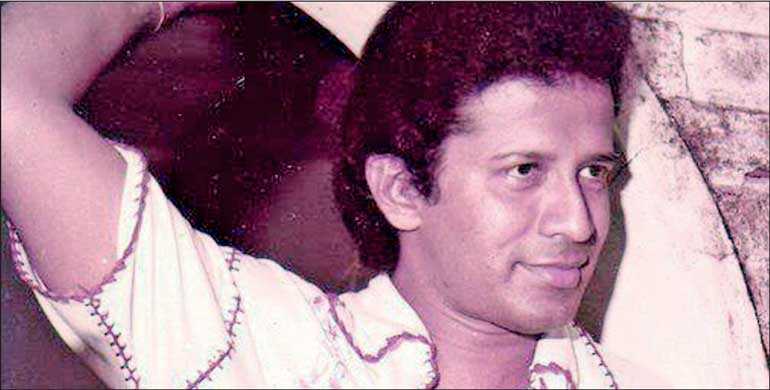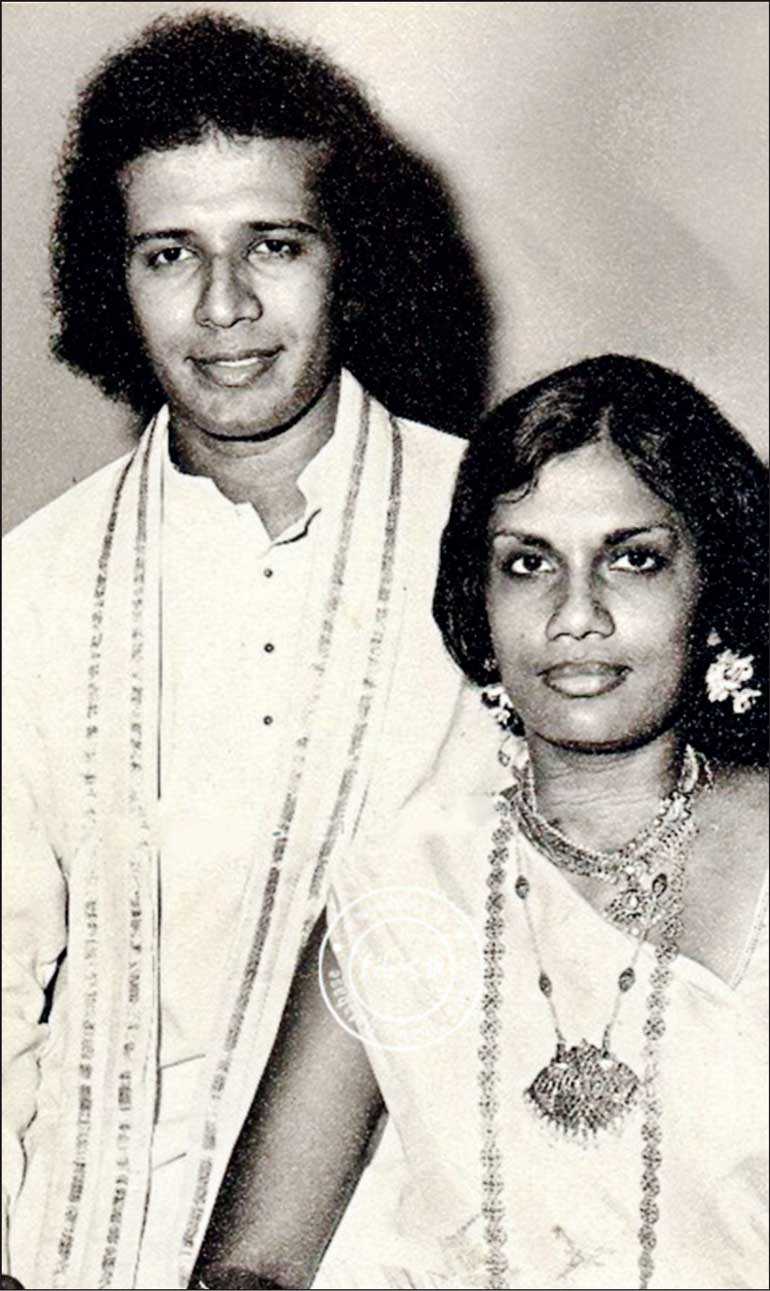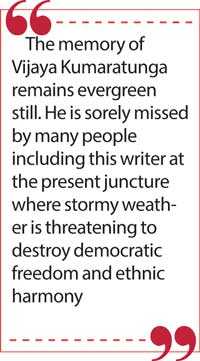Monday Apr 07, 2025
Monday Apr 07, 2025
Wednesday, 7 October 2020 00:05 - - {{hitsCtrl.values.hits}}

Vijaya Kumaratunga

Vijaya and Chandrika
Kovilage Vijaya Anthony Kumaratunga, known to the world as Vijaya Kumaratunga, was born in Seeduwa on 9 October 1945. Vijaya was an endearing personality with an enduring vision whom I liked,  admired and respected very much.
admired and respected very much.
He was a man who envisaged the transformation of Sri Lanka into an inclusive, multi-ethnic, egalitarian and plural nation. A much-loved man of the masses who may have altered the destiny of this resplendent isle in a very positive manner, had he not been felled in the prime of life by foul assassins. A man whose worth is increasingly valued in the present time where communal discord is deliberately promoted for short-term political gain.
I write this week about the beloved actor-turned-politician Vijaya Kumaratunga whose 75th birth anniversary falls on 9 October.
I have written some articles about Vijaya in the past. I will be drawing on some of them in writing this column which will focus on his political career. Also I must mention that Vijaya’s surname was originally spelled ‘Kumaranatunga’. It was as Vijaya Kumaranatunga that he blazed a trail on screen. Subsequently, the name was modified from Kumaranatunga to ‘Kumaratunga’. I shall however be referring to him as Kumaratunga in this article though he was actually known as Kumaranatunga for the greater part of his life. Also his name has been spelled as both ‘Wijaya’ and ‘Vijaya’. I shall refer to him as Vijaya in this article.
Acting his accredited profession
Thirty-two years have passed since his brutal assassination but the handsome film star-politico remains evergreen in the collective memory of his numerous fans and followers. In his thespian career of two decades, the dashing and debonair Vijaya enthralled millions of filmgoers with his scintillating screen performances.
He had acted in 114 films at the time of his demise. Subsequently eight more of his films were released after his death. Thus Vijaya’s final tally of films is 122. It is said that he had acted without getting any payment in 13 films. Almost all of his films were financial successes at the box office. Due to the political machinations in the cinema sphere, Vijaya was seldom bedecked with laurels for his acting skills but as far as the film-going masses were concerned, he was their popular idol. He was voted Most Popular Actor for eight years successively.
Vijaya starred mainly in run-of-the-mill movies that entertained but he did act in some films that were different and made a difference too; 23 of the films acted in by Vijaya are regarded as artistic ‘avant garde’ movies within the Sinhala cinema sphere. Like Sinhala cinema’s superstar Gamini Fonseka, Vijaya Kumaratunga too was commercially valued and artistically acclaimed as a film actor.
But politics his chosen vocation
Acting was his accredited profession but politics was Vijaya Kumaratunga’s chosen vocation. Possessing left-leaning views and also being closely related to Prof. Carlo Fonseka, Vijaya was involved with the Lanka Sama Samaja Party (LSSP) in his youthful days. He later joined the Sri Lanka Freedom Party (SLFP) and became its Katana organiser.
Vijaya contested the Katana constituency unsuccessfully against Wijepala Mendis of the United National Party (UNP) in July 1977. As is well known, the SLFP was utterly routed by the UNP at the 1977 polls. Wijepala Mendis, who was the Katana sitting MP, defeated Vijaya Kumaratunga by a majority of 4,212 votes. Wijepala polled 23,950 to Vijaya’s 19,738.
Despite losing elections, Vijaya plunged zestfully into SLFP politics. He was the livewire behind the island-wide campaigns protesting the deprivation of Sirima Bandaranaike’s civic rights in 1980. I can yet recall the press conference held at Rosemead place by Mrs. Bandaranaike in October 1980. She was flanked by lawyers V.W. Kularatne and Gamini Iriyagolla. The atmosphere got “electrified” when Vijaya arrived in a jeep dressed in a strikingly colourful batik sarong and shirt. He was Mrs. Bandaranaike’s son-in-law then.
The romance
He married into the then first family of the SLFP in February 1978 by wooing and winning the hand of Chandrika Bandaranaike. Chandrika was to disclose in a newspaper interview decades after Vijaya’s death that she had met Vijaya for the first time in Kandy in 1977. Although Chandrika had seen a few of his films, it was as the SLFP candidate for Katana in 1977 that Vijaya was first introduced by Anura Bandaranaike to his sister. All SLFP candidates were attending a party conference in Kandy.
Thereafter Vijaya made several trips to Horagolla where Chandrika was residing then. The Katana SLFP candidate began inviting the Party Leader’s daughter for many political meetings in the constituency. Though the SLFP suffered a political debacle in July 1977, Vijaya continued to meet with Chandrika for the ostensible purpose of discussing national and international political issues.
These discussions flowered into a beautiful romance. They married on 20 February 1978. Film Director Lester James Peries was the attesting witness on behalf of Vijaya and former Agriculture and Lands Minister Hector Kobbekaduwe attested for Chandrika. It was a simple ceremony with only 19 guests present.
Vijaya moved in with Chandrika to 63 Rosemead Place after marriage. Later they relocated to residences in Kynsey Road, Borella and Polhengoda Road in Kirulapone. Vijaya and Chandrika have two children. Daughter Yashodara was born in 1979 and son Vimukthi in 1982. Both are medical doctors in Britain now. Vijaya and Chandrika planned to celebrate their 10th wedding anniversary grandly on 20 February 1988. Alas! Vijaya was assassinated four days before that.
Imprisoned by JR
In October 1982 Mrs. Bandaranaike could not contest Presidential Polls because her civic rights had been taken away. Hector Kobbekkaduwe contested as the SLFP candidate. Vijaya and Chandrika actively campaigned for Hector. President J.R. Jayewardene however won and was re-elected as president.
Recognising the political abilities and leadership potential of Vijaya, JR had him locked up along with hundreds of SLFP activists in a makeshift prison in November 1982. Vijaya was later transferred to Welikada and kept in solitary confinement for a while. Severe restrictions were imposed
The pretext under which Vijaya and others were imprisoned was over the allegation that they were engaged in a “Naxalite” conspiracy to overthrow the UNP Government of the day. The so-called “Naxalite plot” was a total fabrication. After winning the Presidential Poll, J.R. Jayewardene ordered a referendum to be held for extending the term of Parliament for a further six years without holding elections. He did not want dynamic persons like Vijaya canvassing against JR’s objective in the referendum. Hence the Naxalite conspiracy allegation was a calculated ruse to prevent Vijaya and his political comrades from participating at the referendum.
Though Gamini Fonseka was an UNPer, the matinee idol opposed Vijaya’s incarceration. He personally met President Jayewardene and appealed for Vijaya’s release. Actor Tony Ranasinghe drafted a petition calling for Vijaya’s release to be signed and sent to JR. Sadly very few in the Sinhala cinema industry had the courage to sign it then. Apart from Tony Ranasinghe only maestro Premasiri Khemadasa, Nanda Malini, Roy de Silva, Sumana Amerasinghe and Suneetha Weerasinghe signed it. Such was the prevailing climate of fear then. Some of us who remember the not-so-distant past can see signs of a similar fear psychosis setting in now.
JR won the referendum in December 1982. Thereafter pursuing the “Naxalite” conspiracy investigation became unnecessary. Vijaya was released in January 1983. Unafraid and unbowed Vijaya began engaging in SLFP politics again. In May 1983 Vijaya contested the Mahara electorate for the SLFP in a by-election and lost by a narrow margin. There was however a lot of intra-party intrigues in the SLFP against Vijaya and Chandrika.
Vijaya found himself unable to continue in the SLFP. In 1984 Vijaya Kumaratunga broke away from the SLFP along with Chandrika and others like T.B. Ilangaratne and Ratnasiri Wickramanayake to form the Sri Lanka Mahajana Pakshaya (SLMP). The SLMP had a broad, refreshing political perspective. Its advent on the Sri Lankan political horizon was like fresh rain pouring on dry, parched earth.
In 1986 Vijaya contested the Minneriya by-election on behalf of the newly-formed SLMP. The UNP won but Vijaya came second, pushing the SLFP to third place. What was most significant about the Minneriya result was that Vijaya was in first place at the first count. The UNP wanted a recount. While counting was on there was a mysterious power blackout. Counting resumed when the lights came on. Lo and behold! Vijaya’s votes had decreased during the blackout!
SLMP and ethnic reconciliation
The SLMP also played a crucial role in trying to bring about ethnic reconciliation. Vijaya Kumaratunga had an accommodative approach towards the long-festering ethnic crisis. He led a delegation inclusive of Chandrika to meet Tamil militant leaders in Tamil Nadu in 1985.
He met people like Anton Balasingham and Lawrence Thilaghar from the LTTE, Umamaheswaran and Vasudeva from PLOTE, Padmanabha and Ketheesh Loganathan from EPRLF and V. Balakumar and Eliyathamby Ratnasabapathy from EROS. Vijaya also met Chief Minister M.G. Ramachandran and had a lengthy dialogue with the actor-turned-politician. Vijaya told a journalist later that MGR had talked about the Tamil film ‘Nankooram’ (Anchor) in which Kumaratunga was lead actor. The Tamil actress Lakshmi was the leading lady.
Vijaya Kumaratunga also went to Jaffna in 1986 when the peninsula was dominated by the Liberation Tigers of Tamil Eelam (LTTE) and met with Tiger leader Sathasivampillai Krishnakumar alias ‘Kittu’ and his spokesperson Srikumar Kanagaratnam alias ‘Rahim’. How this came about is an interesting tale by itself. The LTTE had captured two Sri Lankan soldiers in 1986 and was keeping them in custody. The Tigers decided to derive some political mileage by releasing them unilaterally to a prominent Sinhala political leader who was sympathetic towards the problems faced by Tamils. LTTE supremo Veluppillai Prabhakaran thought of Vasudeva Nanayakkara but Kittu and Rahim felt Vijaya was a better choice.
What happened thereafter was revealed by ‘Rahim’ to me some years later. Initially the LTTE in Jaffna did not even have Vijaya’s telephone number. Rahim phoned T.B. Illangaratne without divulging his identity and obtained the actor’s telephone number. He then called Vijaya and told him who he was. Vijaya suspected a hoax and called him back.
After several calls back and forth Kumaratunga was convinced that the LTTE was serious. He was happy about the LTTE wanting to release the two soldiers. The Tigers invited Vijaya to visit Jaffna with Chandrika. However Chandrika was unable to do so due to some personal reasons and so Vijaya planned to visit Jaffna with Ossie Abeygunasekera. Subsequently Felix Perera also joined them. The trio was given a rousing welcome by the LTTE. They also met with the two soldiers in captivity. It was arranged for Vijaya to return to Jaffna with members of the soldier families and some religious leaders. The soldier duo would be handed over to Vijaya in the presence of family members and religious dignitaries, it was said. Vijaya’s trip to Jaffna and inter-action with the LTTE was extensively filmed and made into a video cassette. In those days there was no internet and the word ‘viral’ had not been popularised as it is now. However the video cassette of Vijaya’s Jaffna trip to meet the LTTE became very popular. Copies were made and circulated widely. Vijaya Kumaratunga became a political hero overnight. More importantly the video helped improve ethnic relations.
Change of plans
The UNP Government and National Security Minister Lalith Athulathmudali got worried. Lalith thought of undermining Vijaya by appropriating ‘credit’ for the release of soldiers. He used his channels of communication with the LTTE and made an offer to release two LTTE suspects in the custody of security forces in return for the soldiers. It must be noted that the LTTE had been prepared to release the two soldiers to Vijaya without expecting a quid pro quo.
Meanwhile another ‘twist’ occurred in the north. The LTTE learnt belatedly that one of their senior leaders Aruna was being held by the Army at the Jaffna Fort. It was believed earlier that Aruna had perished at sea when a Sri Lankan Navy vessel had fired on a LTTE boat.
Aruna hailing from Kalviyankaadu in Jaffna was a very senior Tiger leader and had even functioned as the LTTE Commander for Batticaloa District. However Aruna had not divulged his real identity to the Navy when he was picked up by sailors after the Tiger boat had capsized. Aruna had identified himself as ‘Kunju Kumar,’ the helmsman or ‘oatti’ of the boat and claimed to have been hired by the Tigers to steer the vessel. Thus Aruna remained in army custody without the security forces realising they had a prize catch in their hands.
Once the LTTE in the north confirmed that Aruna was alive in Army custody, their plans changed. They grasped Athulathmudali’s offer and began negotiating quietly. While clandestine negotiations were going on, Vijaya Kumaratunga arrived in Jaffna with the religious leaders and family members. The LTTE gave them a warm welcome and allowed family members to meet and spend time with the soldiers. The Jaffna Tiger Commander Kittu even offered ‘ata pirikara’ to the Buddhist monks. The Tigers however declined to release the soldiers as arranged earlier.
A disappointed Vijaya returned emptyhanded. National Security Minister Lalith Athulathumudali was jubilant at Vijaya’s discomfiture and expedited the exchange of prisoners with the LTTE. But he was left with a lot of egg on his face when it became known that Kunju Kumar was actually Aruna and that the Government had unwittingly let slip the topmost Tiger they had ever captured alive up to that time.
To strike a personal note, it was I – working then as Colombo Correspondent of ‘The Hindu’ – who scooped the story of the Government releasing Aruna to the Tigers without knowing who he was.
Killed by the JVP
Vijaya Kumaratunga also welcomed the Indo-Lanka Accord of 1987, thereby incurring the wrath of the Rohana Wijeweera-led Janatha Vimukthi Peramuna (JVP). He criticised the JVP boldly. Referring to the Anti-Indian hysteria propagated by the JVP and its fellow travellers, Vijaya said that even Lord Buddha would be declared persona non grata in Sri Lanka by the JVP because the enlightened one was regarded as the noblest son of India.
The JVP was furious. Vijaya Kumaratunga was killed by the JVP just four days before his 10th wedding anniversary on 20 February. The history of Sri Lanka may have been entirely different had Vijaya Kumaratunga not been cut down so cruelly in the prime of his life. A life that was so constructive and full of promise. Vijaya Kumaratunga successfully illuminated the Sinhala cinematic skies for two decades. As his involvement in politics began increasing, he began to decrease the time devoted for films. Despite the popularity and wealth he gained through cinema, Vijaya was willing to sacrifice those for the sake of the country and its people. It was his patriotism and the fervent desire to work for the betterment of the nation that propelled Vijaya into playing an active role in politics. Ultimately it was ‘politics’ that ended his life.
Vijaya Kumaratunga was shot dead in cold blood on 16 February 1988. He was standing near the front gate of his Kirulapone residence on Polhengoda road and talking to an acquaintance when the assailants travelling in a two-wheeler struck.
Vijaya was shot twice in the back and fell to the ground. The gunman then got off the motorcycle pillion and walked up to Vijaya, who was lying motionless, and pumped more bullets into his head and face. Thus ended the life of a charismatic leader who may very well have altered the destiny of this nation if he was not cruelly killed at the age of 42.
Vijaya Kumaratunga’s funeral was held on 21 February 1988 at Independence Square. A record crowd attended it. One can still remember the emotionally powerful moment when Chandrika bade farewell to her husband and comrade with upraised hands giving a clenched fist salute!
The memory of Vijaya Kumaratunga remains evergreen still. He is sorely missed by many people including this writer at the present juncture where stormy weather is threatening to destroy democratic freedom and ethnic harmony.
(D.B.S. Jeyaraj can be reached at [email protected])